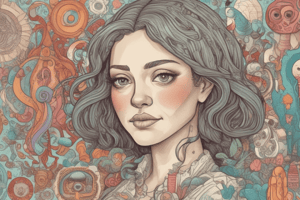Podcast
Questions and Answers
Compare and contrast Freud's psychoanalytic theory with Jung's theory of the collective unconscious. How do these theories differ in their understanding of the unconscious mind's influence on personality?
Compare and contrast Freud's psychoanalytic theory with Jung's theory of the collective unconscious. How do these theories differ in their understanding of the unconscious mind's influence on personality?
Freud emphasizes personal unconscious drives, while Jung focuses on a shared, inherited collective unconscious of universal archetypes.
Describe how the humanistic perspective contrasts with the psychodynamic perspective in understanding personality. What is the primary difference in their views on human nature and motivation?
Describe how the humanistic perspective contrasts with the psychodynamic perspective in understanding personality. What is the primary difference in their views on human nature and motivation?
Humanistic perspective emphasizes inherent goodness and self-actualization, while psychodynamic perspective focuses on unconscious drives and conflicts.
Explain how trait theory attempts to describe personality. How does the trait perspective differ from the social-cognitive perspective in explaining human behavior?
Explain how trait theory attempts to describe personality. How does the trait perspective differ from the social-cognitive perspective in explaining human behavior?
Trait theory uses consistent characteristics to define personality, whereas the social-cognitive perspective focuses on how thoughts and social interactions influence behavior.
How do the concepts of self-efficacy and self-esteem relate to the social-cognitive perspective of personality? Explain how these beliefs influence behavior and personality development.
How do the concepts of self-efficacy and self-esteem relate to the social-cognitive perspective of personality? Explain how these beliefs influence behavior and personality development.
Explain the concept of 'SIR' (Smooth Interpersonal Relations) in Filipino culture. How does it influence conflict resolution and social interactions?
Explain the concept of 'SIR' (Smooth Interpersonal Relations) in Filipino culture. How does it influence conflict resolution and social interactions?
Describe the Filipino trait of Bahala Na. What are the potential positive and negative consequences of this attitude?
Describe the Filipino trait of Bahala Na. What are the potential positive and negative consequences of this attitude?
Analyze the impact of both heredity and environment on personality development, providing specific examples. Which do you believe has a greater contribution?
Analyze the impact of both heredity and environment on personality development, providing specific examples. Which do you believe has a greater contribution?
Consider the four humors theory. What are the four humors, and how are they theorized to relate to different temperaments? How does this compare to what we know about personality today?
Consider the four humors theory. What are the four humors, and how are they theorized to relate to different temperaments? How does this compare to what we know about personality today?
How did Karen Horney's perspective challenge traditional Freudian psychoanalytic theory? What specific aspects of personality development did she emphasize?
How did Karen Horney's perspective challenge traditional Freudian psychoanalytic theory? What specific aspects of personality development did she emphasize?
How can 'Utang na Loob' be both a positive and negative influence in Filipino social interactions and relationships?
How can 'Utang na Loob' be both a positive and negative influence in Filipino social interactions and relationships?
Flashcards
Personality
Personality
Enduring pattern of behaviors, emotions, and thoughts.
Collective Unconscious
Collective Unconscious
Universal set of ideas, feelings, images, and symbols inherited from ancestors.
Psychoanalytic Theory
Psychoanalytic Theory
Behavior motivated by unconscious desires.
Traits
Traits
Signup and view all the flashcards
Observational learning
Observational learning
Signup and view all the flashcards
Factor analysis
Factor analysis
Signup and view all the flashcards
Heredity
Heredity
Signup and view all the flashcards
Smooth Interpersonal Relations (SIR)
Smooth Interpersonal Relations (SIR)
Signup and view all the flashcards
Pakikisama
Pakikisama
Signup and view all the flashcards
Utang na Loob
Utang na Loob
Signup and view all the flashcards
Study Notes
- Study notes pertaining to personality and related topics
Theoretical Foundations of Personality
- Hippocrates was a physician in ancient Greece
- Personality is derived from the Latin term "persona," meaning mask
- Humorism is the theory of four humors: yellow bile, black bile, phlegm, and blood
- Dispositions include being grumpy, melancholy, calm, and cheerful
- Four humors include yellow bile, black bile, phlegm, and blood
- Yellow bile causes a grumpy temperament
- Black bile causes a melancholy temperament
- Phlegm causes a calm temperament
- Blood causes a cheerful temperament
- Personality is an enduring pattern of behaviors, emotions, and thoughts
- L.A. King (2008) defined personality as a combination of factors influencing behavior, thought, motivation, and emotion
- Traits are a combination of factors influencing behavior, thought, motivation, and emotion
- Uniqueness makes each individual distinct
- Behavior is consistently influenced by personality
The Psychodynamic Perspectives
- Sigmund Freud was an Austrian physician who developed psychoanalytic theory
- Psychoanalytic theory suggests behavior that is motivated by the unconscious
- The unconscious is the part of personality containing memories, beliefs, feelings, urges, and drives
- Personality must expose the unconscious to be understood
- Carl Jung developed the concept of the collective unconscious
- The collective unconscious is a universal set of ideas, feelings, images, and symbols inherited from ancestors and nonhuman animals
Horney's Neo-Freudian Perspective
- Karen Horney was a first-wave feminist psychologist
- Personality development is influenced by social relationships, especially parent-child dynamics
- Cultural factors were first to emphasize the role of culture in shaping personality
Adler's Perspective
- Alfred Adler proposed that the primary human motivation is striving for superiority
The Humanistic Perspectives
- This perspective emphasizes the inherent goodness of people
- Carl Rogers emphasized self-actualization and positive regard
- Abraham Maslow popularized the concept of self-actualization
- Self-actualization is reaching one's highest potential
- Motivation is driven by needs, starting from basic needs to higher ones
The Trait Perspectives
- Trait theory explains basic traits to describe personality
- Traits are consistent characteristics and behaviors across situations
- Personality is defined by these traits
- Gordon Allport proposed categories of traits
- Cardinal traits are dominant traits directing most activities (e.g., honesty, sociability)
Cattell and Eysenck's Factoring out Personality Theory
- Factor analysis is a statistical technique to identify associations among variables
- Personality traits are identified through factor analysis
- General patterns are revealed by analyzing large numbers of variables
- Cattell identified 16 pairs of source traits as basic personality dimensions
- Factor analysis was used by Cattell and Eysenck to identify personality traits
- Eysenck identified three major personality dimensions
- Extraversion is the degree of sociability
- Neuroticism is emotional stability
- Psychoticism is the degree of reality distortion
The Social-Cognitive Perspectives
- B.F. Skinner views humans as infinitely changeable through learning
- The learning process shapes new behavior patterns
- Personality is molded through learned behavior patterns
- Cognition includes thoughts, feelings, expectations, values influencing personality
- Observational learning is learning by observing others' actions and consequences
- Albert Bandura emphasized the prediction of outcomes without actual behavior
- Self-efficacy is the belief in personal capability
- Self-esteem is positive and negative self-evaluations
Meaning and Nature of Personality
- Importance of Personality Development
Factors Affecting Personality
- Heredity is the transmission of traits from parents to offspring through genes
- Physical traits include characteristics like eye color, nose size, hair, and skin color
- Mental traits include intelligence and other mental capacities
- Inherited traits, such as physical attributes (e.g., beauty), can influence confidence
- Environment is the total stimulation from conception to death
- People, such as family, relatives, peers, and friends, influence behavior and perception
- Events are impactful life experiences shaping personality (e.g., challenges leading to resilience)
- Places, such as home, school, and workplace, influence worldview and well-being
- Culture is a way of life, including practices and rituals that shape personality (e.g., religious rituals)
Filipino Personality and Character
- Shaped by foreign influences, mixed cultures, and traits
- Traits are intertwined with personality, categorized as positive (to cultivate) and negative (to eliminate)
- Smooth Interpersonal Relations (SIR) means avoiding conflict and getting along with others
- Pakikisama means yielding to the group for unanimous decisions
- Go-between is a mediator to avoid direct conflict
- Euphemismis using polite language to avoid harshness
- Hiya means shame or self-esteem in relation to authority, preventing wrongdoing
- Bahala Na is a fatalistic attitude, trusting God to take care of everything, avoiding responsibility
- Ningas Kugon is initial enthusiasm fading quickly, linked to low achievement motivation
- Utang na Loob is a debt of gratitude, reciprocity, especially between children and parents, but can have negative consequences like bribery
- Hospitality is welcoming guests and offering the best, often at the expense of family members
- Amoral Familism is individualism within the family, difficulty looking beyond the family circle, social individualism
Filipino Positive Traits
- Easygoing: Ranked easiest to get along with in Asia by PERC
- Respectful: Use of Opo/Po with elders and Mano Po greeting tradition
- Religious: Prays before meals and before bed
- Positive Attitude: Loves to laugh, even in crisis
- Helpful: Demonstrated in bayanihan tradition
- Resilient: Bounces back from tragedy, remaining hopeful
- Optimistic: Ranked as the 6th most positive people globally (2012)
- Cheerful & Open: Friendly, nonjudgmental, warm, and enjoy life
Filipino Negative Traits:
- Manana Habit: Tendency to procrastinate and leave tasks undone
- Early Parenthood: Giving birth at a young age
- Dramatic: Emotional and demonstrative, especially in public
- Use of Bad Language: Often uses foul language
- Pride & Arrogance: Difficulty accepting defeat or losing face
- Always Late: Punctuality issues
- Attention-Seeking: Calling attention
Studying That Suits You
Use AI to generate personalized quizzes and flashcards to suit your learning preferences.




